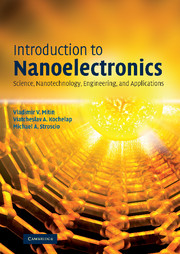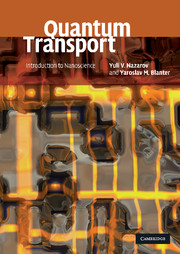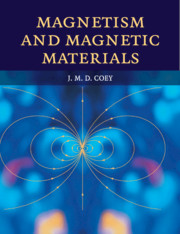Refine listing
Actions for selected content:
881 results in Ebooks in nanotechnology
1 - Growth of III–V semiconductor quantum dots
- from Part I - Nanostructure design and structural properties of epitaxially grown quantum dots and nanowires
-
-
- Book:
- Quantum Dots
- Published online:
- 05 August 2012
- Print publication:
- 19 July 2012, pp 3-20
-
- Chapter
- Export citation
Contents
-
- Book:
- Quantum Dots
- Published online:
- 05 August 2012
- Print publication:
- 19 July 2012, pp v-x
-
- Chapter
- Export citation
Frontmatter
-
- Book:
- Quantum Dots
- Published online:
- 05 August 2012
- Print publication:
- 19 July 2012, pp i-iv
-
- Chapter
- Export citation
Part III - Optical properties of quantum dots in photonic cavities and plasmon-coupled dots
-
- Book:
- Quantum Dots
- Published online:
- 05 August 2012
- Print publication:
- 19 July 2012, pp 135-136
-
- Chapter
- Export citation
Index
-
- Book:
- Quantum Dots
- Published online:
- 05 August 2012
- Print publication:
- 19 July 2012, pp 356-358
-
- Chapter
- Export citation
Part VI - Single dots for future telecommunications applications
-
- Book:
- Quantum Dots
- Published online:
- 05 August 2012
- Print publication:
- 19 July 2012, pp 317-318
-
- Chapter
- Export citation
17 - Graphene quantum dots: transport experiments and local imaging
- from Part V - Electron transport in quantum dots fabricated by lithographic techniques from III–V semiconductors and graphene
-
-
- Book:
- Quantum Dots
- Published online:
- 05 August 2012
- Print publication:
- 19 July 2012, pp 296-316
-
- Chapter
- Export citation
14 - Nuclear spin effects in quantum dot optics
- from Part IV - Quantum dot nano-laboratory: magnetic ions and nuclear spins in a dot
-
-
- Book:
- Quantum Dots
- Published online:
- 05 August 2012
- Print publication:
- 19 July 2012, pp 237-252
-
- Chapter
- Export citation
10 - Photon statistics in quantum dot micropillar emission
- from Part III - Optical properties of quantum dots in photonic cavities and plasmon-coupled dots
-
-
- Book:
- Quantum Dots
- Published online:
- 05 August 2012
- Print publication:
- 19 July 2012, pp 169-184
-
- Chapter
- Export citation
6 - Coherent control of quantum dot excitons using ultra-fast optical techniques: the role of acoustic phonons
- from Part II - Manipulation of individual quantum states in quantum dots using optical techniques
-
-
- Book:
- Quantum Dots
- Published online:
- 05 August 2012
- Print publication:
- 19 July 2012, pp 103-117
-
- Chapter
- Export citation
19 - Deterministic single quantum dot cavities at telecommunication wavelengths
- from Part VI - Single dots for future telecommunications applications
-
-
- Book:
- Quantum Dots
- Published online:
- 05 August 2012
- Print publication:
- 19 July 2012, pp 341-355
-
- Chapter
- Export citation
2 - Single semiconductor quantum dots in nanowires: growth, optics, and devices
- from Part I - Nanostructure design and structural properties of epitaxially grown quantum dots and nanowires
-
-
- Book:
- Quantum Dots
- Published online:
- 05 August 2012
- Print publication:
- 19 July 2012, pp 21-40
-
- Chapter
- Export citation
Part I - Nanostructure design and structural properties of epitaxially grown quantum dots and nanowires
-
- Book:
- Quantum Dots
- Published online:
- 05 August 2012
- Print publication:
- 19 July 2012, pp 1-2
-
- Chapter
- Export citation
Part V - Electron transport in quantum dots fabricated by lithographic techniques from III–V semiconductors and graphene
-
- Book:
- Quantum Dots
- Published online:
- 05 August 2012
- Print publication:
- 19 July 2012, pp 253-254
-
- Chapter
- Export citation
15 - Electrically controlling single spin coherence in semiconductor nanostructures
- from Part V - Electron transport in quantum dots fabricated by lithographic techniques from III–V semiconductors and graphene
-
-
- Book:
- Quantum Dots
- Published online:
- 05 August 2012
- Print publication:
- 19 July 2012, pp 255-276
-
- Chapter
- Export citation
3 - Atomic-scale analysis of self-assembled quantum dots by cross-sectional scanning, tunneling microscopy, and atom probe tomography
- from Part I - Nanostructure design and structural properties of epitaxially grown quantum dots and nanowires
-
-
- Book:
- Quantum Dots
- Published online:
- 05 August 2012
- Print publication:
- 19 July 2012, pp 41-60
-
- Chapter
- Export citation
4 - Studies of the hole spin in self-assembled quantum dots using optical techniques
- from Part II - Manipulation of individual quantum states in quantum dots using optical techniques
-
-
- Book:
- Quantum Dots
- Published online:
- 05 August 2012
- Print publication:
- 19 July 2012, pp 63-85
-
- Chapter
- Export citation

Introduction to Nanoelectronics
- Science, Nanotechnology, Engineering, and Applications
-
- Published online:
- 05 June 2012
- Print publication:
- 06 December 2007

Quantum Transport
- Introduction to Nanoscience
-
- Published online:
- 05 June 2012
- Print publication:
- 28 May 2009

Magnetism and Magnetic Materials
-
- Published online:
- 05 June 2012
- Print publication:
- 25 March 2010
